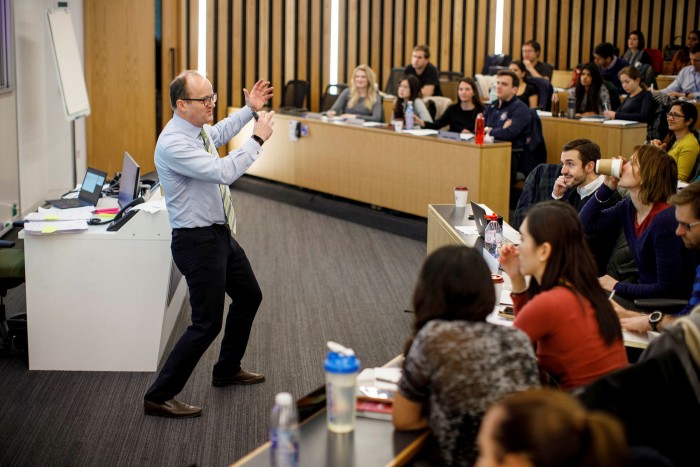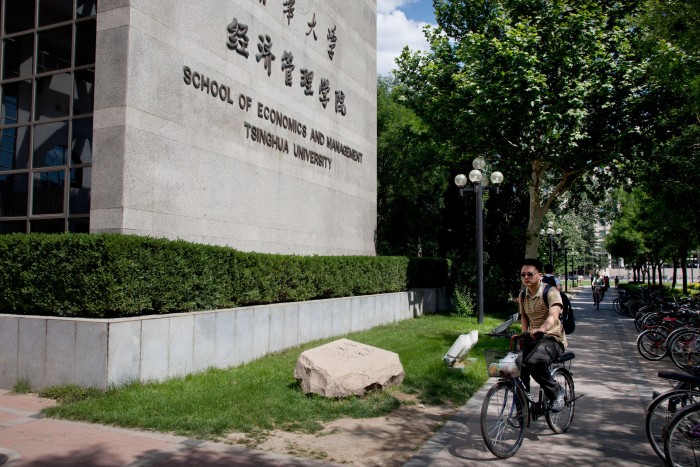FT Masters in Management Ranking 2021: demand surges

Roula Khalaf, Editor of the FT, selects her favourite stories in this weekly newsletter.
The University of St Gallen in Switzerland has topped the Financial Times 2021 ranking of masters in management degrees for the 11th year in a row, achieving the highest score among 100 leading providers — a list dominated by European business schools.
Despite the economic disruption caused by coronavirus, average salaries reported by alumni of all participating providers were up slightly: to $81,537 three years after they completed their courses, compared with $79,985 in 2020.
St Gallen’s graduates had among the highest weighted salaries three years after finishing their Masters in Strategy and International Management, at $123,999, and rated their school highly for helping them achieve their professional aims and for its careers advice.
At a time of uncertainty over employment prospects for undergraduates, many top schools reported a surge in demand for the masters in management (MiM), which typically is taken by students with little or no prior professional work experience.
FT Masters in Management ranking 2021 — top 100

Find out which schools are in our ranking of Masters in Management degrees. Learn how the table was compiled and read the rest of our coverage at www.ft.com/mim.
“There is a strong growth in interest in studying, including online,” said Andrew Crisp, co-founder of CarringtonCrisp, an education consultancy. “An undergraduate degree isn’t enough for many employers, so students are thinking that, if they are going to stand out, they need something more.”
Josep Franch Bullich, dean of Esade in Barcelona, which is ranked joint 16th in 2021 for its standalone MSc in International Management, said applications were up by a third last year and remained at similar levels this year.
He added that recent undergraduates are opting for the MSc instead of working for one or two years, given the pandemic’s effect on job opportunities. Candidates are trusting primarily the top brands, with a smaller surge in demand for less prestigious schools, he said.
The FT’s ranking gives strong credit for high salaries and salary increases three years after completion of the programme. It awards additional points for factors such as value for money, aims achieved, gender balance and diversity of international representation among students, faculty and school advisory boards. Women made up at least 50 per cent of student numbers at half of the business schools, although only nine reported that their faculties comprised as many women as men.
The ranking seeks to compare courses of varied length, size and structure, including some — such as the masters at the Indian Institute of Management in Bangalore — primarily offered to domestic students who succeed in a highly competitive entrance exam.

Four top French business schools — HEC Paris, Essec, ESCP and Edhec — ranked in the top tier of 14 leading schools assessed by the FT. Two UK schools — London Business School (LBS) and Imperial — were also in this tier, in a sign of the continued strength of the UK for domestic and international students, despite uncertainties caused by Brexit. Schools from Ireland, the Netherlands, Spain, Sweden, Germany and the Czech Republic also featured.
Oliver Ashby, MiM programme director at LBS, which reported 96 per cent of its students were in employment three months after graduating, said: “We are still getting strong interest from EU nationals. London remains tremendously attractive.” He added that changes to the UK’s visa regime that allow international students to remain in the country for two years after graduating while they seek a job or launch a start-up have helped to bolster demand.
In a sign of the value placed by employers on students who take a degree split between different schools around the world, the Global 3 Masters in Management — a three-way partnership between Virginia: McIntire in the US, Lingnan in China and Esade in Spain — also ranked in the FT’s top tier.
Alumni of the Global Alliance in Management Education (Cems), which offers an additional competitive qualification to students who study at two of its 34 partner business schools, also fared well. They reported average salaries three years after completion of $98,977.
Highest new entrant: Tsinghua University

Beijing’s Tsinghua University is the highest new entrant to the ranking, in 20th place. The school is in the top five for value for money and career progress, which measures the changes in seniority of alumni in the three years between degree completion and today. The economics and statistics courses in the MiM programme were rated highly by graduates.
By Leo Cremonezi
While their salaries were lower overall, alumni of Qtem (Quantitative Techniques for Economics and Management) programmes — an additional competitive qualification offered by 25 business schools — reported a substantial 70 per cent increase in remuneration between their first job after their MiM and three years later.
Over the past 18 months, coronavirus has forced business schools to offer teaching primarily online and limited the scope for students to travel as part of their study. To reflect this — and to reduce the credit given for short-term foreign travel, which contributes to carbon emissions — the weighting in the FT rankings for international study experience was reduced.
Tim Mescon, chief officer for Europe, Middle East and Africa at AACSB International, the accreditation body, said there was “red hot” student demand for MiM courses to include insights into sustainability. There was also a fresh focus on topics such as supply chains, blockchain and inclusiveness, as well as the importance of ensuring that graduates demonstrate “workforce readiness”.
Comments